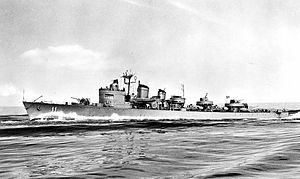Visby-class destroyer

HMS Visby
|
|
| Class overview | |
|---|---|
| Name: | Visby class |
| Operators: |
|
| Preceded by: | Göteborg class |
| Succeeded by: | Öland class |
| Built: | 1942–1944 |
| In commission: | 1943–1982 |
| Planned: | 4 |
| Completed: | 4 |
| Retired: | 4 |
| General characteristics | |
| Type: | Destroyer/Frigate |
| Displacement: | 1,135–1,320 tons |
| Length: | 98 m (322 ft) |
| Beam: | 9 m (30 ft) |
| Draught: | 3.8 m (12 ft) |
| Speed: | 39 kn (72 km/h; 45 mph) |
| Complement: | 155 |
| Armament: |
|
| Aircraft carried: | 1 helicopter as frigate |
The Visby class was a Swedish World War II destroyer class. During the years 1942–1944 four ships, Visby, Sundsvall, Hälsingborg and Kalmar, were built and delivered to the Swedish navy. The ships were a part of Sweden's military buildup during the war. Under this period the ships were used as neutral guards and escort ships. In 1965 the ships were modified and rebuilt as frigates. Two of the ships were decommissioned in 1978 and the last two followed in 1982.
During the first years of the War Sweden's armed forces went through a massive reinforcement. In 1941, as part of this build-up, the Swedish government ordered four new destroyers for the Swedish navy, of which two were replacements for three destroyers sunk in an explosion on 17 September that year. The new class would be based on the older Göteborg-class destroyer that were classified as a "Town-class destroyer" and because of this classified as "Modified Town-class destroyers", (modifierad Stadsjagare). In total four ships were built, two at the Götaverken-shipyard and two at the Eriksbergs shipyard.
The design was largely based on the Göteborg-class destroyer, with a similar main armament of three 120 mm (4.7 in) M/24 Bofors guns in three single mounts, but in an improved arrangement, with the second gun mounted aft, firing over the third gun rather than between the funnels as in the earlier destroyers, thus improving fields of fire. Anti-aircraft armament was also improved, consisting of four Bofors 40 mm guns in a twin mount on the ship's centreline between the banks of torpedo tubes, and two single mounts mounted port and starboard further forward. These were supplemented by several 20 mm cannon, also by Bofors. The ships' torpedo armament remained six 53 cm (21 in) torpedo tubes in two triple mounts. The ships were fitted for minelaying, with up to 20 mines being carried, while anti-submarine armament consisted of four depth charge throwers.
The hull was lengthened compared with the Göteborg class, giving a length between perpendiculars of 95.0 metres (311 ft 8 in) and an overall length of 98 metres (321 ft 6 in) with a beam of 9.0 metres (29 ft 6 in) and a draught of 3.8 metres (12 ft 6 in). Displacement was 1,135 long tons (1,153 t) standard and 1,320 long tons (1,340 t) full load. A square stern was fitted. Like the Göteborg class, the superstructure was built using light alloys to save weight. Three 3-drum boilers fed superheated steam to two de Laval geared steam turbines, driving two shafts and giving 36,000 shaft horsepower (27,000 kW), allowing a speed of 39 knots (72 km/h; 45 mph) to be reached.
...
Wikipedia
